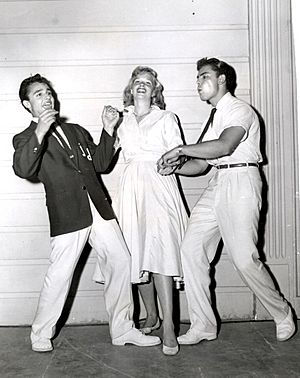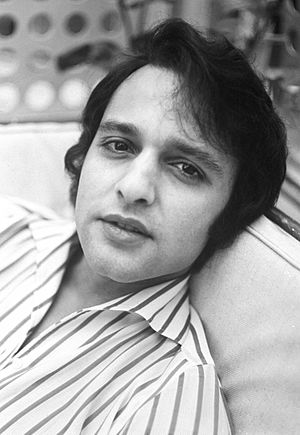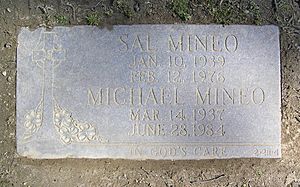Sal Mineo facts for kids
Quick facts for kids
Sal Mineo
|
|
|---|---|

Mineo in 1973
|
|
| Born |
Salvatore Mineo Jr.
January 10, 1939 The Bronx, New York, U.S.
|
| Died | February 12, 1976 (aged 37) |
| Resting place | Gate of Heaven Cemetery |
| Other names | The Switchblade Kid |
| Occupation | Actor |
| Years active | 1951–1976 |
Salvatore Mineo Jr. (born January 10, 1939 – died February 12, 1976) was a famous American actor. He was best known for his role as John "Plato" Crawford in the movie Rebel Without a Cause (1955). This role earned him a nomination for an Academy Award for Best Supporting Actor when he was only 17 years old. This made him one of the youngest people ever nominated in that category.
Mineo also starred in many other films. These included Crime in the Streets and Giant (both from 1956). He was also in Exodus (1960), where he won a Golden Globe award. He received another Academy Award nomination for his work in Exodus. Other notable films include The Longest Day (1962) and Escape from the Planet of the Apes (1971).
Contents
Early Life and Acting Start
Mineo was born in The Bronx, New York City. His parents, Josephine and Salvatore Mineo Sr., made coffins for a living. His family came from Sicily, Italy. His father was born in Italy, and his mother's family was also Italian. Sal's sister Sarina and his brothers Michael and Victor also became actors.
Sal went to the Quintano School for Young Professionals. He was proud of his Italian heritage. He was one of the few Italian-American actors of his time who kept his real last name.
Becoming a Child Actor
Mineo's mother helped him start dancing and acting lessons when he was very young. His first time on stage was in a play called The Rose Tattoo (1951). He also played a young prince in the musical The King and I. In this play, he acted alongside the famous Yul Brynner. Brynner helped Mineo improve his acting skills.
Mineo also appeared on television as a teenager. He was on a music show called Jukebox Jury. He made his first movie appearance in Six Bridges to Cross (1955). He even got the part over another future star, Clint Eastwood. Mineo also got a role in The Private War of Major Benson (1955), acting with Charlton Heston.
Rise to Stardom

Mineo became very famous after his role in Rebel Without a Cause (1955). In the movie, he played John "Plato" Crawford. Plato was a sensitive teenager who admired the main character, Jim Stark, played by James Dean. Mineo's performance was so good that he was nominated for an Academy Award. He was only 17, making him one of the youngest nominees ever.
After the movie, Mineo received thousands of fan letters. Young fans would crowd around him at public events. He was a big celebrity in Hollywood and New York.
In the movie Giant (1956), Mineo played Angel Obregon II. This was a Mexican boy who died in World War II. Many of his next roles were similar to his character in Rebel Without a Cause. He often played troubled teenagers. For example, in the Disney adventure Tonka (1958), Mineo played a young Sioux named White Bull. His character tamed a wild horse named Tonka, who later became the famous Comanche.
By the late 1950s, Mineo was a huge star. People sometimes called him the "Switchblade Kid." He got this nickname from his role as a criminal in the movie Crime in the Streets (1956).
In 1957, Mineo also tried singing. He recorded a few songs and an album. Two of his songs became Top 40 hits in the United States. One song, "Start Movin' (In My Direction)", reached number 9 on the Billboard pop chart. It sold over a million copies and earned a gold record. He also played the famous drummer Gene Krupa in the movie The Gene Krupa Story (1959).
Mineo worked hard to play different kinds of characters. He played a Native American in Tonka (1958) and a Mexican boy in Giant (1956). In Exodus (1960), he played a Jewish person who survived the Holocaust. For this role, he won a Golden Globe Award and got his second Academy Award nomination.
Career Changes
By the early 1960s, Mineo was getting older. He could no longer play the teenage roles that made him famous. He tried out for the movie Lawrence of Arabia (1962) but did not get the part. Mineo appeared in The Longest Day (1962), playing a soldier who died after landing in Sainte-Mère-Église. Mineo was confused by his sudden drop in popularity. He later said, "One minute it seemed I had more movie offers than I could handle; the next, no one wanted me."
Mineo was the model for a painting called The New Adam (1963). This painting is now in the Guggenheim Museum. Mineo also appeared on a TV show called The Patty Duke Show in 1964.
Mineo played a character who followed people in the movie Who Killed Teddy Bear (1965). This role did not help his career much. Even though critics liked his acting, he was again playing similar characters. A highlight from this time was his role as Uriah in The Greatest Story Ever Told (1965). Mineo also appeared as a guest star in the TV series Combat! several times in 1966.
In 1969, Mineo went back to the stage. He directed a play in Los Angeles called Fortune and Men's Eyes. The play received good reviews. Mineo's last movie role was a small part in Escape from the Planet of the Apes (1971). He played a chimpanzee named Dr. Milo.
In 1975, Mineo appeared in an episode of the TV show Columbo. One of his last roles was a guest spot on the TV series S.W.A.T. (1975). In this role, he played a leader of a group, similar to Charles Manson.
By 1976, Mineo's career was starting to improve. He was acting in a play called P.S. Your Cat Is Dead in San Francisco. He received many good reviews for his role. He then moved to Los Angeles with the play.
Personal Life
Mineo met English actress Jill Haworth while filming Exodus in 1960. They played young lovers in the movie. Mineo and Haworth were together for many years and were even engaged at one point. They remained very close friends until Mineo's death.
Death
On the night of February 12, 1976, Mineo was returning home from a play rehearsal. After parking his car, he was attacked and stabbed by someone. Mineo was buried at Gate of Heaven Cemetery in Hawthorne, New York.
Filmography
Film
| Year | Title | Role | Notes |
|---|---|---|---|
| 1955 | Six Bridges to Cross | Jerry (boy) | |
| 1955 | The Private War of Major Benson | Cadet Col. Sylvester Dusik | |
| 1955 | Rebel Without a Cause | John "Plato" Crawford | Nominated—Academy Award for Best Supporting Actor |
| 1956 | Crime in the Streets | Angelo "Baby" Gioia, a.k.a. Bambino | |
| 1956 | Somebody Up There Likes Me | Romolo | |
| 1956 | Giant | Angel Obregón II | |
| 1956 | Rock, Pretty Baby | Angelo Barrato | |
| 1957 | Dino | Dino Minetta | |
| 1957 | The Young Don't Cry | Leslie "Les" Henderson | |
| 1958 | Tonka | White Bull | |
| 1959 | A Private's Affair | Luigi Maresi | |
| 1959 | The Gene Krupa Story | Gene Krupa | |
| 1960 | Exodus | Dov Landau | Won—Golden Globe Award for Best Supporting Actor – Motion Picture Nominated—Academy Award for Best Supporting Actor |
| 1962 | Escape from Zahrain | Ahmed | |
| 1962 | The Longest Day | Pvt. Martini | |
| 1964 | Cheyenne Autumn | Red Shirt | |
| 1965 | The Greatest Story Ever Told | Uriah | |
| 1965 | Who Killed Teddy Bear? | Lawrence Sherman | |
| 1967 | Stranger on the Run | George Blaylock | |
| 1969 | Krakatoa, East of Java | Leoncavallo Borghese | |
| 1969 | 80 Steps to Jonah | Jerry Taggart | |
| 1971 | Escape from the Planet of the Apes | Dr. Milo |
Television
| Year | Title | Role | Notes |
|---|---|---|---|
| 1952 | The Vision of Father Flanagan | Les | TV Movie |
| 1952 | A Woman For The Ages | Charles | TV Movie |
| 1953 | Omnibus | Paco | "The Capitol of the World" |
| 1954 | Janet Dean, Registered Nurse | Tommy Angelo | "The Magic Horn" |
| 1955 | Big Town | "Juvenile Gangs" | |
| 1955 | Omnibus | "The Bad Men" | |
| 1955 | The Philco Television Playhouse | "The Trees" | |
| 1955 | Frontiers of Faith | "The Man on the 6:02" | |
| 1956 | Look Up and Live | "Nothing to Do" | |
| 1956 | The Alcoa Hour | Paco | "The Capitol of the World", "The Magic Horn" |
| 1956 | Westinghouse Studio One | "Dino" | |
| 1956 | Look Up and Live | "Nothing to Do" | |
| 1956 | Lux Video Theatre | "Tabloid" | |
| 1956 | Screen Directors Playhouse | "The Dream" | |
| 1956 | Climax! | Miguel | "Island in the City" |
| 1957 | The Ed Sullivan Show | Himself | Episodes 10.42, 10.48 |
| 1957 | Kraft Suspense Theatre | Tony Russo | "Barefoot Soldier", "Drummer Man" |
| 1957 | Kraft Music Hall | Himself | Episode 10.8 |
| 1958 | The DuPont Show of the Month | Aladdin | "Cole Porter's Aladdin" |
| 1958 | Pursuit | Jose Garcia | "The Garcia Story" |
| 1959 | The Ann Sothern Show | Nicky Silvero | "The Sal Mineo Story" |
| 1962 | The DuPont Show of the Week | Coke | "A Sound of Hunting" |
| 1963 | The Greatest Show on Earth | Billy Archer | "The Loser" |
| 1964 | Kraft Suspense Theatre | Ernie | "The World I Want" |
| 1964 | Dr. Kildare | Carlos Mendoza | "Tomorrow is a Fickle Girl" |
| 1964 | Combat! | Private Kogan | "The Hard Way Back" |
| 1965 | The Patty Duke Show | Himself | "Patty Meets a Celebrity" |
| 1965 | Burke's Law | Lew Dixon | "Who Killed the Rabbit's Husband?" |
| 1966 | Combat! | Vinnick | "Nothing to Lose" |
| 1966 | Combat! | Marcel Paulon | "The Brothers" |
| 1966 | Mona McCluskey | "The General Swings at Dawn" | |
| 1966 | Run for Your Life | Tonio | "Sequestro!: Parts 1 and 2" |
| 1966 | Court Martial | Lt. Tony Bianchi | "The House Where He Lived" |
| 1967 | The Dangerous Days of Kiowa Jones | Bobby Jack Wilkes | TV Movie |
| 1967 | Bob Hope Presents the Chrysler Theatre | Doctoroff | "A Song Called Revenge" |
| 1967 | Stranger on the Run | George Blaylock | TV Movie |
| 1968 | Hawaii Five-O | Bobby George | "Tiger By The Tail" |
| 1969 | The Name of the Game | Sheldon | "A Hard Case Of The Blues" |
| 1970 | Mission Impossible | Mel Bracken | Flip Side |
| 1970 | The Challengers | Angel de Angelo | TV Movie |
| 1970 | The Name of the Game | Wade Hillary | "So Long, Baby, and Amen" |
| 1971 | My Three Sons | Jim Bell | "The Liberty Bell" |
| 1971 | The Immortal | Tsinnajinni | "Sanctuary" |
| 1971 | Dan August | Mort Downes | "The Worst Crime" |
| 1971 | In Search of America | Nick | TV Movie |
| 1971 | How to Steal an Airplane | Luis Ortega | TV Movie |
| 1972 | The Family Rico | Nick Rico | TV Movie |
| 1973 | Griff | President Gamal Zaki | "Marked for Murder" |
| 1973 | Harry O | Walter Scheerer | "Such Dust as Dreams Are Made On" |
| 1974 | Tenafly | Jerry Farmer | "Man Running" |
| 1974 | Police Story | Stippy | "The Hunters" |
| 1975 | Columbo | Rachman Habib | "A Case of Immunity" |
| 1975 | Hawaii Five-O | Eddie | "Hit Gun for Sale" |
| 1975 | Harry O | Broker | "Elegy for a Cop" |
| 1975 | SWAT | Roy | "Deadly Tide: Parts 1 and 2" |
| 1975 | SWAT | Joey Hopper | "A Coven of Killers" |
| 1975 | Police Story | Fobbes | "Test of Brotherhood" |
| 1976 | Ellery Queen | James Danello | "The Adventure of the Wary Witness" |
| 1976 | Joe Forrester | Parma | "The Answer", (final appearance) |
Awards and Nominations
| Institution | Category | Year | Work | Result |
|---|---|---|---|---|
| Academy Awards | Best Supporting Actor | 1956 | Rebel Without a Cause | Nominated |
| 1961 | Exodus | Nominated | ||
| Golden Globe Awards | Best Supporting Actor | 1961 | Won | |
| Primetime Emmy Awards | Best Single Performance by an Actor | 1957 | Studio One | Nominated |
| Laurel Awards | Top Male Supporting Performance | 1961 | Exodus | Won |
See Also
 In Spanish: Sal Mineo para niños
In Spanish: Sal Mineo para niños
- List of youngest Academy Award nominees for Best Supporting Actor
- List of actors with Academy Award nominations



